Hexin Liu
Mind-Paced Speaking: A Dual-Brain Approach to Real-Time Reasoning in Spoken Language Models
Oct 10, 2025Abstract:Real-time Spoken Language Models (SLMs) struggle to leverage Chain-of-Thought (CoT) reasoning due to the prohibitive latency of generating the entire thought process sequentially. Enabling SLMs to think while speaking, similar to humans, is attracting increasing attention. We present, for the first time, Mind-Paced Speaking (MPS), a brain-inspired framework that enables high-fidelity, real-time reasoning. Similar to how humans utilize distinct brain regions for thinking and responding, we propose a novel dual-brain approach, employing a "Formulation Brain" for high-level reasoning to pace and guide a separate "Articulation Brain" for fluent speech generation. This division of labor eliminates mode-switching, preserving the integrity of the reasoning process. Experiments show that MPS significantly outperforms existing think-while-speaking methods and achieves reasoning performance comparable to models that pre-compute the full CoT before speaking, while drastically reducing latency. Under a zero-latency configuration, the proposed method achieves an accuracy of 92.8% on the mathematical reasoning task Spoken-MQA and attains a score of 82.5 on the speech conversation task URO-Bench. Our work effectively bridges the gap between high-quality reasoning and real-time interaction.
Bi-directional Context-Enhanced Speech Large Language Models for Multilingual Conversational ASR
Jun 16, 2025Abstract:This paper introduces the integration of language-specific bi-directional context into a speech large language model (SLLM) to improve multilingual continuous conversational automatic speech recognition (ASR). We propose a character-level contextual masking strategy during training, which randomly removes portions of the context to enhance robustness and better emulate the flawed transcriptions that may occur during inference. For decoding, a two-stage pipeline is utilized: initial isolated segment decoding followed by context-aware re-decoding using neighboring hypotheses. Evaluated on the 1500-hour Multilingual Conversational Speech and Language Model (MLC-SLM) corpus covering eleven languages, our method achieves an 18% relative improvement compared to a strong baseline, outperforming even the model trained on 6000 hours of data for the MLC-SLM competition. These results underscore the significant benefit of incorporating contextual information in multilingual continuous conversational ASR.
NTU Speechlab LLM-Based Multilingual ASR System for Interspeech MLC-SLM Challenge 2025
Jun 16, 2025Abstract:This report details the NTU Speechlab system developed for the Interspeech 2025 Multilingual Conversational Speech and Language Model (MLC-SLM) Challenge (Task I), where we achieved 5th place. We present comprehensive analyses of our multilingual automatic speech recognition system, highlighting key advancements in model architecture, data selection, and training strategies. In particular, language-specific prompts and model averaging techniques were instrumental in boosting system performance across diverse languages. Compared to the initial baseline system, our final model reduced the average Mix Error Rate from 20.2% to 10.6%, representing an absolute improvement of 9.6% (a relative improvement of 48%) on the evaluation set. Our results demonstrate the effectiveness of our approach and offer practical insights for future Speech Large Language Models.
EASY: Emotion-aware Speaker Anonymization via Factorized Distillation
May 21, 2025Abstract:Emotion plays a significant role in speech interaction, conveyed through tone, pitch, and rhythm, enabling the expression of feelings and intentions beyond words to create a more personalized experience. However, most existing speaker anonymization systems employ parallel disentanglement methods, which only separate speech into linguistic content and speaker identity, often neglecting the preservation of the original emotional state. In this study, we introduce EASY, an emotion-aware speaker anonymization framework. EASY employs a novel sequential disentanglement process to disentangle speaker identity, linguistic content, and emotional representation, modeling each speech attribute in distinct subspaces through a factorized distillation approach. By independently constraining speaker identity and emotional representation, EASY minimizes information leakage, enhancing privacy protection while preserving original linguistic content and emotional state. Experimental results on the VoicePrivacy Challenge official datasets demonstrate that our proposed approach outperforms all baseline systems, effectively protecting speaker privacy while maintaining linguistic content and emotional state.
Enhancing Non-Core Language Instruction-Following in Speech LLMs via Semi-Implicit Cross-Lingual CoT Reasoning
Apr 29, 2025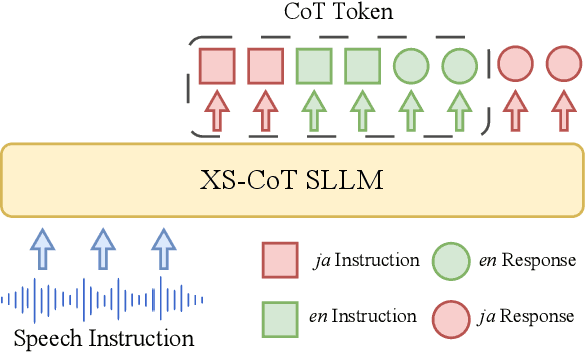
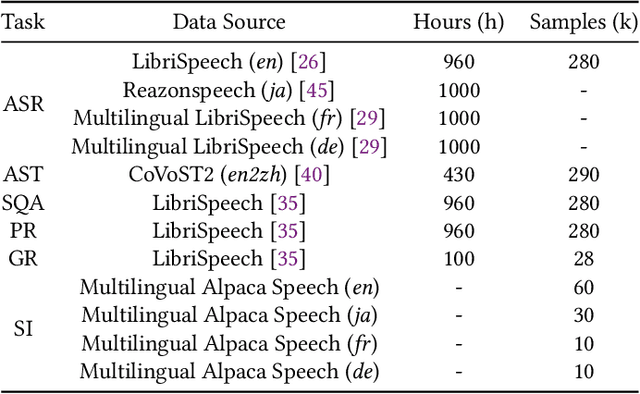


Abstract:Large language models have been extended to the speech domain, leading to the development of speech large language models (SLLMs). While existing SLLMs demonstrate strong performance in speech instruction-following for core languages (e.g., English), they often struggle with non-core languages due to the scarcity of paired speech-text data and limited multilingual semantic reasoning capabilities. To address this, we propose the semi-implicit Cross-lingual Speech Chain-of-Thought (XS-CoT) framework, which integrates speech-to-text translation into the reasoning process of SLLMs. The XS-CoT generates four types of tokens: instruction and response tokens in both core and non-core languages, enabling cross-lingual transfer of reasoning capabilities. To mitigate inference latency in generating target non-core response tokens, we incorporate a semi-implicit CoT scheme into XS-CoT, which progressively compresses the first three types of intermediate reasoning tokens while retaining global reasoning logic during training. By leveraging the robust reasoning capabilities of the core language, XS-CoT improves responses for non-core languages by up to 45\% in GPT-4 score when compared to direct supervised fine-tuning on two representative SLLMs, Qwen2-Audio and SALMONN. Moreover, the semi-implicit XS-CoT reduces token delay by more than 50\% with a slight drop in GPT-4 scores. Importantly, XS-CoT requires only a small amount of high-quality training data for non-core languages by leveraging the reasoning capabilities of core languages. To support training, we also develop a data pipeline and open-source speech instruction-following datasets in Japanese, German, and French.
GenSE: Generative Speech Enhancement via Language Models using Hierarchical Modeling
Feb 05, 2025Abstract:Semantic information refers to the meaning conveyed through words, phrases, and contextual relationships within a given linguistic structure. Humans can leverage semantic information, such as familiar linguistic patterns and contextual cues, to reconstruct incomplete or masked speech signals in noisy environments. However, existing speech enhancement (SE) approaches often overlook the rich semantic information embedded in speech, which is crucial for improving intelligibility, speaker consistency, and overall quality of enhanced speech signals. To enrich the SE model with semantic information, we employ language models as an efficient semantic learner and propose a comprehensive framework tailored for language model-based speech enhancement, called \textit{GenSE}. Specifically, we approach SE as a conditional language modeling task rather than a continuous signal regression problem defined in existing works. This is achieved by tokenizing speech signals into semantic tokens using a pre-trained self-supervised model and into acoustic tokens using a custom-designed single-quantizer neural codec model. To improve the stability of language model predictions, we propose a hierarchical modeling method that decouples the generation of clean semantic tokens and clean acoustic tokens into two distinct stages. Moreover, we introduce a token chain prompting mechanism during the acoustic token generation stage to ensure timbre consistency throughout the speech enhancement process. Experimental results on benchmark datasets demonstrate that our proposed approach outperforms state-of-the-art SE systems in terms of speech quality and generalization capability.
Adapting Whisper for Code-Switching through Encoding Refining and Language-Aware Decoding
Dec 24, 2024


Abstract:Code-switching (CS) automatic speech recognition (ASR) faces challenges due to the language confusion resulting from accents, auditory similarity, and seamless language switches. Adaptation on the pre-trained multi-lingual model has shown promising performance for CS-ASR. In this paper, we adapt Whisper, which is a large-scale multilingual pre-trained speech recognition model, to CS from both encoder and decoder parts. First, we propose an encoder refiner to enhance the encoder's capacity of intra-sentence swithching. Second, we propose using two sets of language-aware adapters with different language prompt embeddings to achieve language-specific decoding information in each decoder layer. Then, a fusion module is added to fuse the language-aware decoding. The experimental results using the SEAME dataset show that, compared with the baseline model, the proposed approach achieves a relative MER reduction of 4.1% and 7.2% on the dev_man and dev_sge test sets, respectively, surpassing state-of-the-art methods. Through experiments, we found that the proposed method significantly improves the performance on non-native language in CS speech, indicating that our approach enables Whisper to better distinguish between the two languages.
SAV-SE: Scene-aware Audio-Visual Speech Enhancement with Selective State Space Model
Nov 12, 2024
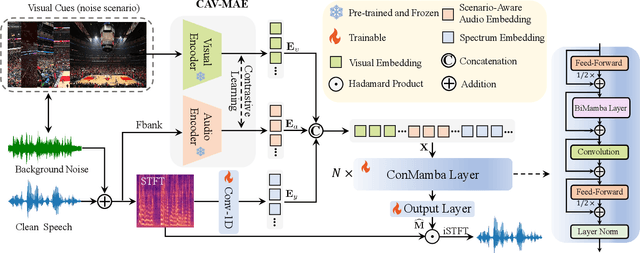

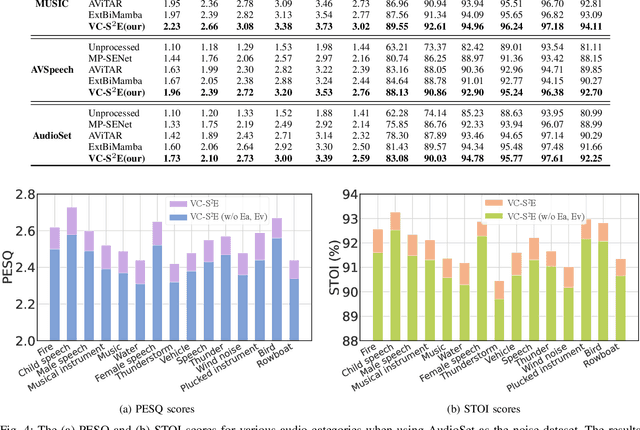
Abstract:Speech enhancement plays an essential role in various applications, and the integration of visual information has been demonstrated to bring substantial advantages. However, the majority of current research concentrates on the examination of facial and lip movements, which can be compromised or entirely inaccessible in scenarios where occlusions occur or when the camera view is distant. Whereas contextual visual cues from the surrounding environment have been overlooked: for example, when we see a dog bark, our brain has the innate ability to discern and filter out the barking noise. To this end, in this paper, we introduce a novel task, i.e. SAV-SE. To our best knowledge, this is the first proposal to use rich contextual information from synchronized video as auxiliary cues to indicate the type of noise, which eventually improves the speech enhancement performance. Specifically, we propose the VC-S$^2$E method, which incorporates the Conformer and Mamba modules for their complementary strengths. Extensive experiments are conducted on public MUSIC, AVSpeech and AudioSet datasets, where the results demonstrate the superiority of VC-S$^2$E over other competitive methods. We will make the source code publicly available. Project demo page: https://AVSEPage.github.io/
Selective State Space Model for Monaural Speech Enhancement
Nov 09, 2024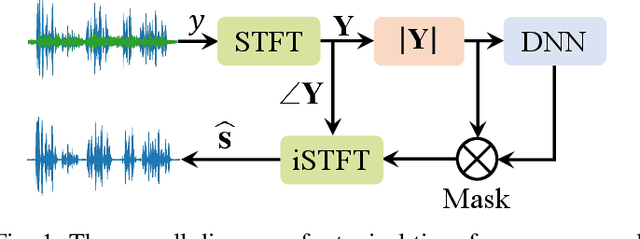

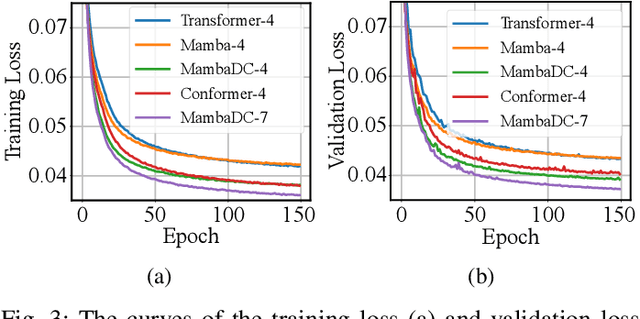
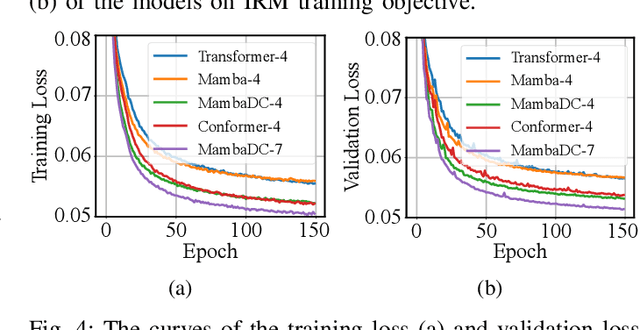
Abstract:Voice user interfaces (VUIs) have facilitated the efficient interactions between humans and machines through spoken commands. Since real-word acoustic scenes are complex, speech enhancement plays a critical role for robust VUI. Transformer and its variants, such as Conformer, have demonstrated cutting-edge results in speech enhancement. However, both of them suffers from the quadratic computational complexity with respect to the sequence length, which hampers their ability to handle long sequences. Recently a novel State Space Model called Mamba, which shows strong capability to handle long sequences with linear complexity, offers a solution to address this challenge. In this paper, we propose a novel hybrid convolution-Mamba backbone, denoted as MambaDC, for speech enhancement. Our MambaDC marries the benefits of convolutional networks to model the local interactions and Mamba's ability for modeling long-range global dependencies. We conduct comprehensive experiments within both basic and state-of-the-art (SoTA) speech enhancement frameworks, on two commonly used training targets. The results demonstrate that MambaDC outperforms Transformer, Conformer, and the standard Mamba across all training targets. Built upon the current advanced framework, the use of MambaDC backbone showcases superior results compared to existing \textcolor{black}{SoTA} systems. This sets the stage for efficient long-range global modeling in speech enhancement.
Mamba in Speech: Towards an Alternative to Self-Attention
May 22, 2024



Abstract:Transformer and its derivatives have achieved success in diverse tasks across computer vision, natural language processing, and speech processing. To reduce the complexity of computations within the multi-head self-attention mechanism in Transformer, Selective State Space Models (i.e., Mamba) were proposed as an alternative. Mamba exhibited its effectiveness in natural language processing and computer vision tasks, but its superiority has rarely been investigated in speech signal processing. This paper explores solutions for applying Mamba to speech processing using two typical speech processing tasks: speech recognition, which requires semantic and sequential information, and speech enhancement, which focuses primarily on sequential patterns. The results exhibit the superiority of bidirectional Mamba (BiMamba) for speech processing to vanilla Mamba. Moreover, experiments demonstrate the effectiveness of BiMamba as an alternative to the self-attention module in Transformer and its derivates, particularly for the semantic-aware task. The crucial technologies for transferring Mamba to speech are then summarized in ablation studies and the discussion section to offer insights for future research.
 Add to Chrome
Add to Chrome Add to Firefox
Add to Firefox Add to Edge
Add to Edge